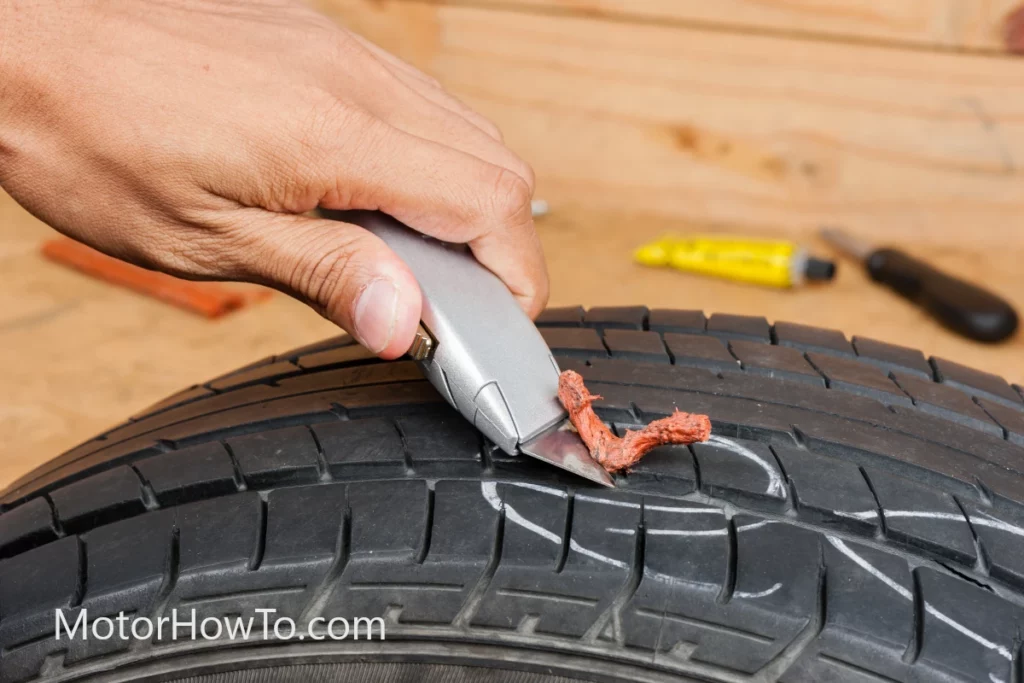Electric vehicles (EVs) have become increasingly popular due to their efficiency and eco-friendliness. Like all other vehicles, EVs are susceptible to tire punctures.
When a tire puncture occurs, it is important to address it promptly to avoid further damage to the tire and potential safety risks while driving.
One common solution is to plug the tire, but EV owners may wonder how long it takes to wait after a tire plug.
Depending on the severity and width of puncture, location of puncture, condition of the tire, type plug used and manufacturer’s ideal recommendations it can take a few minutes to a few hours to wait after a tire plug on an electric vehicle. It is important to ensure the tire is properly sealed and the plug is installed correctly.

While tire plugs can provide a quick and convenient fix for a punctured tire, it is crucial to follow proper guidelines and allow sufficient time for the repair to set before driving.
This really depends on various factors, such as below:
- Severity and width of the puncture
- Location of the puncture on the tire
- Condition of the tire
- Type of tire plug and specification used
- Manufacturer’s ideal recommendations
In this article, we will explore the various factors that affect the waiting time after a tire plug on an EV, so you can make an informed decision and stay safe on the road.
Related:
- Can My EV Drive Long Distances With Plugged Tire? (3 Alternatives)
- Can I Put Tilted Wheels And Tires On A EV? (Read This First)
- Do You Need Specific Tires For Tesla? (Explained For Beginners)
Can I Drive Long Distance With A Plugged Tire
Driving on a plugged tire for a long distance is not recommended, as it can pose a safety risk for you and other drivers on the road. While tire plugs can provide a quick and convenient fix for a punctured tire, they are not a permanent solution and are only meant to be a temporary fix.
This really depends on various factors, such as below:
- Severity and width of the puncture
- Location of the puncture on the tire
- Condition of the tire
- Type of tire plug and specification used
- Manufacturer’s ideal recommendations
In general, limiting driving on a plugged tire to no more than 100 miles at a speed of no more than 50 miles per hour is recommended.
This allows the plug to set and bond with the tire, reducing the risk of the plug coming loose or failing while driving.
Remember that driving on a plugged tire for an extended period of time can increase the risk of a blowout or other tire-related issues, which can be dangerous while driving.
If you need to drive a long distance with a plugged tire, it’s best to have it inspected and repaired by a professional before embarking on your journey.
This can help ensure the tire is in good condition and reduce the risk of a tire-related issue occurring while driving.
Check out this great video on how fix the tire puncture with a tyre plug and repair kit.
How Effective Is A Tire Plug?
A tire plug is a common solution for repairing a punctured tire, but many drivers wonder how effective it is in the long run.
The effectiveness of a tire plug depends on the below factors:
- Severity and width of the puncture
- Location of the puncture on the tire
- Condition of the tire
- Type of tire plug and specification used
- Manufacturer’s ideal recommendations
A tire plug can be an effective solution for repairing a punctured tire, particularly if the puncture is small and on the tire’s tread.
The plug is designed to fill the hole and create a seal, preventing air from escaping and keeping the tire inflated.
If the plug is properly installed and the tire is in good condition, it can provide a long-lasting fix for the puncture.
It’s always best to have a punctured tire inspected and repaired by a professional who can assess the damage and determine the best course of action for your safety.
However, it’s important to remember that a tire plug is not a permanent solution and is only meant to be a temporary fix.
Additionally, if the puncture is too large or located on the tire’s sidewall, a tire plug may not be effective, and you may need to replace the tire instead.
Is A Tire Plug A Permanent Fix?
A tire plug is not a permanent fix for a punctured tire, as it is only meant to be a temporary solution to get you to a repair shop or a safer location. While a tire plug can be an effective solution for repairing a punctured tire, it is not designed to be a long-lasting fix.
A tire plug is meant to fill the hole and create a seal, preventing air from escaping and inflating the tire. However, a plug does not address the underlying cause of the puncture, such as a nail or other debris stuck in the tire.
Also, a plugged tire can be weakened and more susceptible to blowouts or other tire-related issues over time, which can be dangerous while driving.
For these reasons, it’s always best to have a punctured tire inspected and repaired by a professional who can assess the damage and determine the best course of action for your safety.
Is A Tire Plug Better Than A Patch?
When repairing a punctured tire, there are two common methods: a tire plug and a patch.
While both methods can provide a temporary fix for a punctured tire, some differences between the two make one method more effective than the other in certain situations.
A tire plug is a quick and easy solution for repairing a punctured tire, as it involves inserting a rubber plug into the hole to create a seal.
The plug is then trimmed flush with the tire surface, and the tire is inflated.
A tire plug is more effective for small punctures on the tire’s tread, as it can provide a quick and effective fix without requiring specialized equipment.
On the other hand, a patch is a more comprehensive solution for repairing a punctured tire, as it involves removing the tire from the rim, inspecting the puncture from the inside, and applying a patch to the inner liner of the tire.
A patch is more effective for larger punctures or punctures on the tire’s sidewall, as it can provide a more secure and long-lasting fix. Additionally, a patch can address any damage to the tire’s inner liner, which can help prevent air from leaking out and keep the tire inflated.
Can A Tire Plug Fail?
A tire plug can fail under certain circumstances. While a properly installed tire plug can provide an effective and temporary fix for a punctured tire, several factors can cause it to fail.
One common reason a tire plug can fail is if the puncture is too large or in the wrong location.
If the puncture is too large or located on the sidewall of the tire, a plug may not be able to provide a proper seal, and the tire may continue to leak air.
Additionally, if the plug is not installed correctly, it can become dislodged or fail to provide a proper seal, which can cause the tire to lose air and become flat.
It’s important to have a punctured tire inspected by a professional to ensure that a plug is the appropriate repair method and is installed correctly.
Conclusion
While a tire plug is a common and quick solution for a punctured tire, it is not a permanent fix and should only be used temporarily to get you to a repair shop or a safer location.
It is important to follow proper guidelines and wait sufficient time for the repair to set before driving, typically at least 24 hours.
The waiting time after plugging a tire on an electric vehicle depends on several factors such as below:
- Severity and width of the puncture
- Location of the puncture on the tire
- Condition of the tire
- Type of tire plug and specification used
- Manufacturer’s ideal recommendations
A tire plug can be an effective solution for repairing a punctured tire.
Driving on a plugged tire for an extended period can increase the risk of a blowout or other tire-related issues, which can be dangerous while driving.
It is crucial to have a punctured tire inspected and repaired by a professional to determine the best course of action.
Sources
How Long Does A Tire Plug Need To Dry?
How Long Can You Drive On A Plugged Tire?
Can I Drive Long Distance with a Plugged Tire?
How Long Does A Tire Plug Last? Is It Safe To Plug In A Tire?



